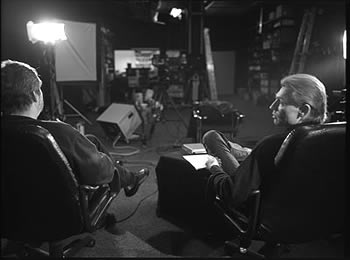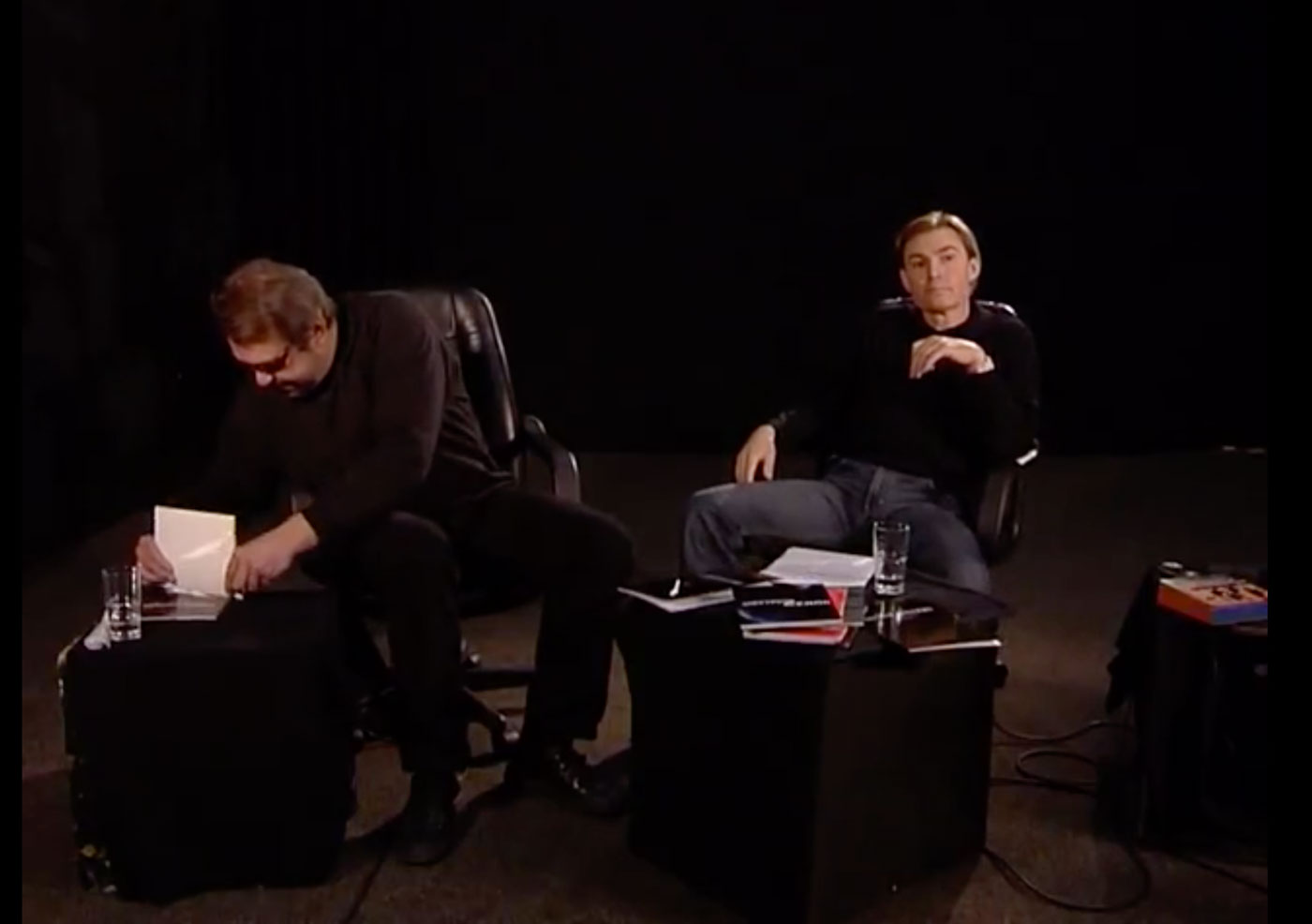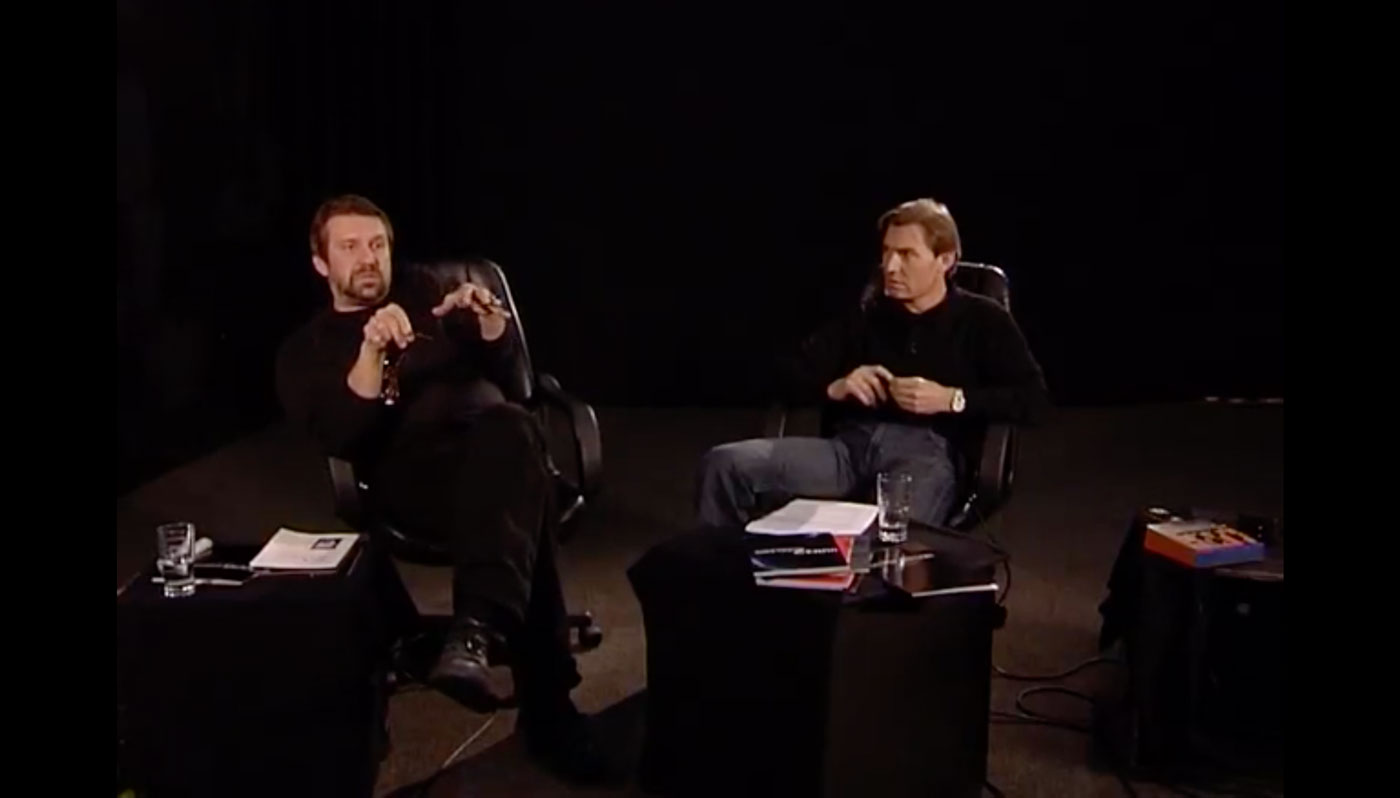Rehearsing Szuper Gallery, 2005
Video, 2 x 30min
The video documents a conversation with and by Susanne Clausen and Pavlo Kerestey as members of Szuper Gallery. It was performed by actors Jurij Rosstalnyi and Artur Galiandin.
It was part of an installation "Rehearsing Szuper Gallery"developed for the exhibition Xenopolis in Munich.
Susanne Clausen and Pawlo Kerestey led Szuper Gallery in Munich from 1994-99, which until then had platformed art from the Ukraine. The gallery hit the headlines due to its presumed connections to the Ukrainian mafia. In the video Ukrainian actors Yuri Rosstalnyi and Arthur Galiandin embody the two artists and gallery organisers and through their performance establish a relationship to the current reception of Ukraine. The actors blend the re-enactment of Szuper Gallery with their own experiences as Eastern European actors in Germany. Fiction and reality merge through improvisation and the staged discussion raises questions about what it means to live and work as an artist and foreigner in exile.
Exceprts from the performance script:
You work under the name Szuper Gallery. It is strange to see this name in an exhibition for example in a list of individual artists. What is Szuper Gallery and what do you do?
In 1995, we were invited by the owner of Szuper Gallery, who had been dealing in Eastern European art until then, to redesign the gallery's program. We started working as curators in the gallery. The owner hoped that this would stimulate the business. Until then, the gallery had mainly focused on Ukrainian art. The first Western buyers travelled to Moscow at the end of the 1980s and looked for cheap future art stars. Artists from the Soviet Union also travelled to Moscow to participate in this market. The buyers went from studio to studio.
In 1988 Sotheby's bought underground art from the Soviet Union for the first time and sold it at relatively high prices in the West. This was a shock to the Soviet artists. Grigory Pruskin, for example, sold 'Fundamental Lexicon' for 240,000 pounds at the auction. The works of Svetlana and Igor Kopustiansky ended up in Elton John's collection. The other artists who created this Russian boom are Bulatov, Kabakov, Chuikov, Jankilewsky or Sacharov. The artists did not even get a tenth of the selling price into their hands, but they were able to conclude contracts with Western art dealers. In general, however, the Western art market seemed less concerned with art than with the marketing of perestroika. Western art dealers quickly learned that working with the 'forbidden Russians' could be very profitable, increasing recognition and prices on the 'non-existent' Soviet art market.
At the same time, Russian collectors and gallery owners established themselves in Moscow. They sought their money to invest in art at a time of inflation. Tatyana Krindelova, who came from the sugar business, imitated the most successful Moscow gasoline baron, Vladimir Regina. For example, she bought a painting from me for 100,000 rubles, which was worth about 10,000 dollars at the time. But in two weeks I couldn't even buy a TV. The gallery owner Marat Guelman collected the money from his father's party coffers to invest in the Ukrainian art scene. Today the Mafia has taken over a large part of the art trade... The Russian artists of the 80s who were recognized in the West emigrated there and sat on their money bags in Berlin and New York and thus became the mythical role model for the generation of the 90s. But this boom lasted only a few years, until shortly after the collapse of the Soviet Union. After this collapse the artists found themselves in their now mostly independent nation states, whose smaller art scenes could no longer be marketed so well in the West. Then the so-called art tourism began, inviting groups of artists from the former Soviet republics, twin cities etc. to the West.
A big travel activity began. For artists there were visas thrown behind at that time. About 10 functionaries always travelled with one artist.
How did Galerie Szuper behave back then?
Shortly after we started in the gallery, the alleged criminal machinations and entanglements of the gallery were reported on television. It was claimed that the gallery was used for the machinations of the Russian Mafia for money laundering. Moreover, an allegedly ordered assassination attempt on an MP in Germany by the Ukrainian president had just been uncovered. Mafia researcher Jürgen Roth was very active in the investigation. Later we were interviewed by him and the interview was broadcasted in the political program Kennzeichen D. We thought that this would at least get us on TV.
The gallery as a cover for criminal activities is rather the exception?
Now, a few years ago we did a work based on a true story that happened in Venice in 1999: a group of clever tricksters from Eastern Europe used their knowledge of the customs of the art market and art trade to bring within a few days at least 12 gallery owners to art works in the millions. The trick was quite simple. A perfect stage for the art trade was staged in Venice, in a rented 17th century palazzo. The gallery owners were invited individually with the targeted paintings, they were then in the house by the Mafiosis, which turned out to be excellent actors, the credible scenery of a collector's family played. The gallery owners were held back by pretended unforeseen family events, the intention to buy could be credibly simulated. This setting seemed so credible to the invited gallery owners that they were persuaded to leave their precious works of art to the family only against a receipt. The next day, the Mafiosis and their works of art had disappeared. The palazzo had been abandoned, the rent for one week had been paid with an uncovered cheque.
What is your relationship to money?
The gallery went bankrupt in 1997, mainly because we were absolutely unable to sell anything. Probably because we had turned the gallery business into an art project. After we closed down, we adopted the name of the gallery. Since then, 'Szuper Gallery' has been an interesting construct for us to act in different situations. There is a nice sentence by Groucho Marx from the Brother's first film: The Cocoanuts: "Money makes you happy but happy makes you no money".
Szuper Gallery looks like an unconventional art project or a contemporary art practice. How far do you want to question the limits of art making?
Szuper Gallery turns out to be an instrument to test a series of strategies, practices and collaborations. As you say, it's strange to see this name as an artist's name. This kind of irritation has always interested us. Our experiences with the commercial art world have influenced and changed our perception.
The artificiality of the system and the resemblance to the structures of organized crime is both fascinating and frustrating at the same time. We noticed that it makes no difference whether you are inside or outside the system, because of course there is no outside anymore. In this situation we started to develop different working strategies, strategies of intervention, smuggling or cooperation with different institutions, with companies and administrative authorities, for example with the police, with a television station or a foreigners authority.
The construct of the gallery allowed us to have access and perform on different stages, even if it is only a 'sham institution', and now the mafia has understood how to appropriate the structures of cultural production. The Russian criminal and Vitali Dyomochka,34, is the first Mafia boss to appear in a real TV gangster series. He plays the boss of a syndicate of organized crime. He 'plays' so credibly that not even Hollywood could have written this role so well. He is highly talented and dedicated to criminal life and he uncovers the shocking reality of the dark underworld. Dyomotchka, boss of the criminal gang 'Podstav, found most of the existing mafia movies to be too unrealistic and therefore created his own series, 'Spets'. We were bored to see the many unrealistic TV and cinema films about the Mafia and organised crime. The series which he partly financed sleber is very successful. Meanwhile he hopes that filmmaking could become a legal form of income and bring him and the other members of the criminal crew prestige in the entertainment business.
Video, 2 x 30min
The video documents a conversation with and by Susanne Clausen and Pavlo Kerestey as members of Szuper Gallery. It was performed by actors Jurij Rosstalnyi and Artur Galiandin.
It was part of an installation "Rehearsing Szuper Gallery"developed for the exhibition Xenopolis in Munich.
Susanne Clausen and Pawlo Kerestey led Szuper Gallery in Munich from 1994-99, which until then had platformed art from the Ukraine. The gallery hit the headlines due to its presumed connections to the Ukrainian mafia. In the video Ukrainian actors Yuri Rosstalnyi and Arthur Galiandin embody the two artists and gallery organisers and through their performance establish a relationship to the current reception of Ukraine. The actors blend the re-enactment of Szuper Gallery with their own experiences as Eastern European actors in Germany. Fiction and reality merge through improvisation and the staged discussion raises questions about what it means to live and work as an artist and foreigner in exile.
Exceprts from the performance script:
You work under the name Szuper Gallery. It is strange to see this name in an exhibition for example in a list of individual artists. What is Szuper Gallery and what do you do?
In 1995, we were invited by the owner of Szuper Gallery, who had been dealing in Eastern European art until then, to redesign the gallery's program. We started working as curators in the gallery. The owner hoped that this would stimulate the business. Until then, the gallery had mainly focused on Ukrainian art. The first Western buyers travelled to Moscow at the end of the 1980s and looked for cheap future art stars. Artists from the Soviet Union also travelled to Moscow to participate in this market. The buyers went from studio to studio.
In 1988 Sotheby's bought underground art from the Soviet Union for the first time and sold it at relatively high prices in the West. This was a shock to the Soviet artists. Grigory Pruskin, for example, sold 'Fundamental Lexicon' for 240,000 pounds at the auction. The works of Svetlana and Igor Kopustiansky ended up in Elton John's collection. The other artists who created this Russian boom are Bulatov, Kabakov, Chuikov, Jankilewsky or Sacharov. The artists did not even get a tenth of the selling price into their hands, but they were able to conclude contracts with Western art dealers. In general, however, the Western art market seemed less concerned with art than with the marketing of perestroika. Western art dealers quickly learned that working with the 'forbidden Russians' could be very profitable, increasing recognition and prices on the 'non-existent' Soviet art market.
At the same time, Russian collectors and gallery owners established themselves in Moscow. They sought their money to invest in art at a time of inflation. Tatyana Krindelova, who came from the sugar business, imitated the most successful Moscow gasoline baron, Vladimir Regina. For example, she bought a painting from me for 100,000 rubles, which was worth about 10,000 dollars at the time. But in two weeks I couldn't even buy a TV. The gallery owner Marat Guelman collected the money from his father's party coffers to invest in the Ukrainian art scene. Today the Mafia has taken over a large part of the art trade... The Russian artists of the 80s who were recognized in the West emigrated there and sat on their money bags in Berlin and New York and thus became the mythical role model for the generation of the 90s. But this boom lasted only a few years, until shortly after the collapse of the Soviet Union. After this collapse the artists found themselves in their now mostly independent nation states, whose smaller art scenes could no longer be marketed so well in the West. Then the so-called art tourism began, inviting groups of artists from the former Soviet republics, twin cities etc. to the West.
A big travel activity began. For artists there were visas thrown behind at that time. About 10 functionaries always travelled with one artist.
How did Galerie Szuper behave back then?
Shortly after we started in the gallery, the alleged criminal machinations and entanglements of the gallery were reported on television. It was claimed that the gallery was used for the machinations of the Russian Mafia for money laundering. Moreover, an allegedly ordered assassination attempt on an MP in Germany by the Ukrainian president had just been uncovered. Mafia researcher Jürgen Roth was very active in the investigation. Later we were interviewed by him and the interview was broadcasted in the political program Kennzeichen D. We thought that this would at least get us on TV.
The gallery as a cover for criminal activities is rather the exception?
Now, a few years ago we did a work based on a true story that happened in Venice in 1999: a group of clever tricksters from Eastern Europe used their knowledge of the customs of the art market and art trade to bring within a few days at least 12 gallery owners to art works in the millions. The trick was quite simple. A perfect stage for the art trade was staged in Venice, in a rented 17th century palazzo. The gallery owners were invited individually with the targeted paintings, they were then in the house by the Mafiosis, which turned out to be excellent actors, the credible scenery of a collector's family played. The gallery owners were held back by pretended unforeseen family events, the intention to buy could be credibly simulated. This setting seemed so credible to the invited gallery owners that they were persuaded to leave their precious works of art to the family only against a receipt. The next day, the Mafiosis and their works of art had disappeared. The palazzo had been abandoned, the rent for one week had been paid with an uncovered cheque.
What is your relationship to money?
The gallery went bankrupt in 1997, mainly because we were absolutely unable to sell anything. Probably because we had turned the gallery business into an art project. After we closed down, we adopted the name of the gallery. Since then, 'Szuper Gallery' has been an interesting construct for us to act in different situations. There is a nice sentence by Groucho Marx from the Brother's first film: The Cocoanuts: "Money makes you happy but happy makes you no money".
Szuper Gallery looks like an unconventional art project or a contemporary art practice. How far do you want to question the limits of art making?
Szuper Gallery turns out to be an instrument to test a series of strategies, practices and collaborations. As you say, it's strange to see this name as an artist's name. This kind of irritation has always interested us. Our experiences with the commercial art world have influenced and changed our perception.
The artificiality of the system and the resemblance to the structures of organized crime is both fascinating and frustrating at the same time. We noticed that it makes no difference whether you are inside or outside the system, because of course there is no outside anymore. In this situation we started to develop different working strategies, strategies of intervention, smuggling or cooperation with different institutions, with companies and administrative authorities, for example with the police, with a television station or a foreigners authority.
The construct of the gallery allowed us to have access and perform on different stages, even if it is only a 'sham institution', and now the mafia has understood how to appropriate the structures of cultural production. The Russian criminal and Vitali Dyomochka,34, is the first Mafia boss to appear in a real TV gangster series. He plays the boss of a syndicate of organized crime. He 'plays' so credibly that not even Hollywood could have written this role so well. He is highly talented and dedicated to criminal life and he uncovers the shocking reality of the dark underworld. Dyomotchka, boss of the criminal gang 'Podstav, found most of the existing mafia movies to be too unrealistic and therefore created his own series, 'Spets'. We were bored to see the many unrealistic TV and cinema films about the Mafia and organised crime. The series which he partly financed sleber is very successful. Meanwhile he hopes that filmmaking could become a legal form of income and bring him and the other members of the criminal crew prestige in the entertainment business.


